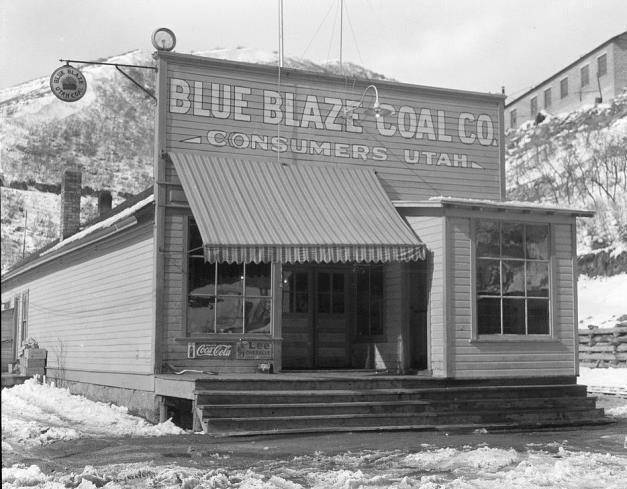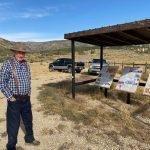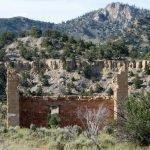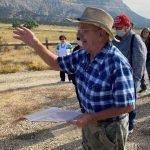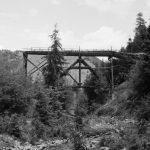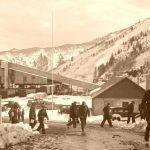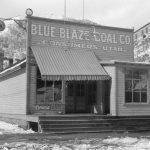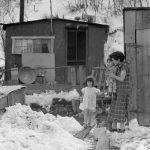By Cynthia Grant
The Emery County Historical Society hosted its fall field trip on Saturday, Sept. 26. Members gathered at 9 a.m. at the Huntington Stake Center for a delightfully sunny and cool journey, complete with some brilliant red and yellow foliage. The destinations included the sites of Coal City, National, Sweets and Consumers coal camps.
Ed Geary, avid local historian and writer, had prepared an informational packet and photos and guided the group to the abandoned mining towns up Consumers Road in Carbon County. Over 30 vehicles and about 60 people began the journey, many of whom “needed a good outing.”
A Carbon County contingent of seven or eighth vehicles was waiting up Consumers’ Road just west of SR6 to join the caravan. The first stop was the site of Coal City, now part of a wildlife management area for the Utah Department of Wildlife Resources. Geary and Robert Potts shared stories of Coal City. In addition, three informational kiosks highlighted the utopian dream of George A. Storrs. Geary livened the day’s narrative with excerpts of stories from J. Eldon Dorman’s “Confessions of a Coal Camp Doctor.”
Around 1917, Storrs acquired the Cedar Mesa Ranch and formed the Great Western Coal Mines Company. His vision was that Coal City would be five miles from the smoke and dust of the mines and occupied by families who would own their homes, and also have small farms to supplement their mining income. He envisioned 2,600 lots for sale. For a short time in the spring of 1923, Storrs even brought in Jack Dempsey, the “Manassa Mauler” and heavyweight boxer.
The town’s name was changed to Dempsey City. Dempsey briefly trained in the basement of the Andreini store, the three rock walls of which are the only significant surviving structures of the town. In May 1923, Dempsey left the area but his training equipment remained in the basement, and the locals made good use of it.
The reality of Coal City was very different than the dream; 200 lots purchased, only four documented farms and a maximum of 100 people living there. The Great Western Coal Mine was disappointing and production began to decline in 1935. The town was essentially abandoned with just two residences occupied by the late 1960s. Pointing out a chimney in the town, Potts told of a Miss Rosevich, the last person who lived up there eight years by herself. She paid a power bill of $8.50 per month. At least three times per year, lightning would blow a fuse, costing the power company $150 to restore the service.
The next stop was National Coal Company purchased in the 1920s. All of the buildings in National were constructed of the same brick material. Geary showed the group a brick in his possession from one of the original buildings. However, little other than a few foundations and all but forgotten rubble remain from the buildings at National. In July 1938, National discontinued mining in the area, going into foreclosure the same year.
Tom Harrison said that his father was born and raised for a time at National Coal camp. This was his first visit to the area. Harrison remembers his father telling of making skis from barrel staves and gliding all the way down the long hill in the winter. The tough walk back up the road convinced him to end his skiing career.
Forging onward, the group continued less than ½ mile to Consumers to view Sweets. The Sweet brothers who developed National also established a town bearing their name in Bryner Canyon. Housing was similar to Consumers with tar paper shacks extending about ½ mile up the canyon. Sweets is significant as the first mine in Utah where the majority of the original miners were Japanese, but Geary said that Dorman seems to represent South Slavs (“Austrians”) as the most prominent ethnic group in the camps.
Initial construction began in 1924. The National Coal and Gordon Creek Coal Companies built the National Coal Railway from Helper to the mining operations. Part of the trestle is still visible over the canyon. Geary said for those interested in a side trip, you can get there after a drive on a nearby dirt road. He also noted that this trestle was famous for its slightly rounded track.
Geary mentioned that Consumers doesn’t exist anymore, so “use your imagination.” Two canyons come together. He shared early photographs of Consumers, including the tipple which spanned the whole canyon width. The concrete foundation where the tipple was attached to the mountain is still visible. Geary also pointed out the crumbling foundations of the Blue Blaze Coal Company store, by far the area’s largest company store. Consumers Mine is on left side of the canyon and coal was brought into the tipple from both sides. Beyond the tipple was the main section of the town.
In 1936, renowned photographer Dorothy Lange was contracted to document “deplorable” conditions at Consumers in what she called the “dumping grounds of the west.” Photos show what the town looked like back then, mostly shacks. More than 300 lived in Consumers at its peak. Geary said that the story of people who lived there doesn’t always tally with that description. Although it was not easy, the Padding family lived in tent a couple of years, even through the winters. They claimed even though you were poor, you always had coal to keep warm, friends nearby, a doctor and a recreation hall to see movies; a great place to grow up, depending on your perspective.
After enjoying a sack lunch, participants of the field trip departed. Some went on the scenic mountain roadway through Scofield, some straight home. Bernice Payne, president of the Emery County Historical Society, would like to thank Geary, Potts and all those who joined in to make the day a wonderful success.
Come join us Oct. 22 as the Emery County Historical Society will meet indoors at the courthouse in Castle Dale. Kent Powell, expert on the subject, will talk about labor in Utah coal mines and the developments of the unions. It was a 30-year struggle to get union recognition in the mines. Now, there is not a union mine left in Utah, Deer Creek being one of the last.

